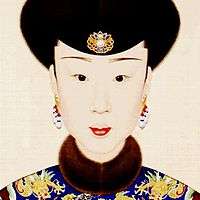Imperial Noble Consort Qinggong
Imperial Noble Consort Qinggong (12 August 1724 – 21 August 1774), of the Han Chinese Bordered Yellow Banner Lu clan, was a consort of the Qianlong Emperor. She was 13 years his junior.
| Imperial Noble Consort Qinggong | |||||
|---|---|---|---|---|---|
 | |||||
| Born | 12 August 1724 (雍正二年 六月 二十四日) | ||||
| Died | 21 August 1774 (aged 50) (乾隆三十九年 七月 十五日) Forbidden City | ||||
| Burial | Yu Mausoleum, Eastern Qing tombs | ||||
| Spouse | |||||
| |||||
| House | Lu (陸; by birth) Aisin Gioro (by marriage) | ||||
| Imperial Noble Consort Qinggong | |||||||
|---|---|---|---|---|---|---|---|
| Traditional Chinese | 慶恭皇貴妃 | ||||||
| Simplified Chinese | 庆恭皇贵妃 | ||||||
| |||||||
Life
Family background
Imperial Noble Consort Qinggong's personal name was not recorded in history.
- Father: Shilong (士隆)
- Four brothers
Yongzheng era
The future Imperial Noble Consort Qinggong was born on the 24th day of the sixth lunar month in the second year of the reign of the Yongzheng Emperor, which translates to 12 August 1724 in the Gregorian calendar.
Qianlong era
It is not known when Lady Lu entered the Forbidden City and was granted the title "First Attendant" by the Qianlong Emperor. She was elevated on 8 May 1748 to "Noble Lady", on 30 July 1751 to "Concubine Qing", and on 4 February 1760 to "Consort Qing".
In 1765, she joined the Qianlong Emperor and his other consorts on an inspection tour to the southern Yangtze delta region.[1] On 14 November 1768, she was elevated to "Noble Consort Qing". She died on 21 August 1774 and was interred in the Yu Mausoleum of the Eastern Qing tombs.
Jiaqing era
On 9 February 1796, the Qianlong Emperor abdicated in favour of his 15th son, Yongyan, and became a Retired Emperor. As the Jiaqing Emperor was raised by Lady Lu in his childhood, he felt grateful to her, so after the Qianlong Emperor died on 7 February 1799, he posthumously elevated her to "Imperial Noble Consort Qinggong".[2]
Titles
- During the reign of the Yongzheng Emperor (r. 1722–1735):
- Lady Lu (from 12 August 1724)
- During the reign of the Qianlong Emperor (r. 1735–1796):
- During the reign of the Jiaqing Emperor (r. 1796–1820):
- Imperial Noble Consort Qinggong (慶恭皇貴妃; from 8 February 1799[7]), second rank consort
In fiction and popular culture
- Portrayed by Au Oi-ling in The Rise and Fall of Qing Dynasty (1988)
- Portrayed by Yu Yang in Ruyi's Royal Love in the Palace (2018). Her maiden name is Lu Muping.
- Portrayed by Li Ruoning in Story of Yanxi Palace (2018). Her maiden name is Lu Wanwan.
See also
- Ranks of imperial consorts in China#Qing
- Royal and noble ranks of the Qing dynasty
Notes
- Ho & Bronson (2004), p. 184.
- Qing Shi Gao vol. 214.
- 乾隆十三年 四月 十二日
- 乾隆十六年 六月 八日
- 乾隆二十四年 十二月 十八日
- 乾隆三十三年 十月 六日
- 嘉慶四年 正月 四日
References
- Ho, Chuimei; Bronson, Bennet (2004). Splendors of China's Forbidden City: The Glorious Reign of Emperor Qianlong (Illustrated ed.). Merrell. ISBN 1858942039.
- Zhao, Erxun (1928). Draft History of Qing (Qing Shi Gao) (in Chinese).